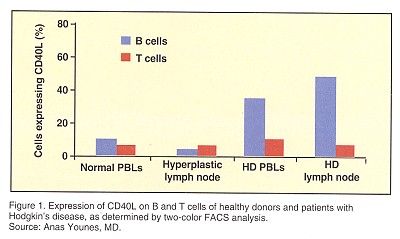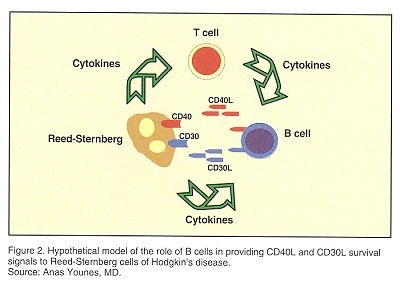Removing B Cells May Improve Hodgkin’s Disease Response
HOUSTON-Removing B cells improves control of classic Hodgkin’s disease and relieves B symptoms, reported Anas Younes, MD. Dr. Younes, associate professor, Department of Lymphoma/Myeloma at the University of Texas M. D. Anderson Cancer Center, Houston, Texas, administered the anti-CD20 monoclonal antibody rituximab (Rituxan) to heavily pretreated patients who had relapsed classic Hodgkin’s disease. The rationale behind this trial, according to Dr.Younes, was that B cells may provide survival and resistance signals to Reed-Sternberg (RS) cells in Hodgkin’s disease.
HOUSTONRemoving B cells improves control of classic Hodgkin’s disease and relieves B symptoms, reported Anas Younes, MD. Dr. Younes, associate professor, Department of Lymphoma/Myeloma at the University of Texas M. D. Anderson Cancer Center, Houston, Texas, administered the anti-CD20 monoclonal antibody rituximab (Rituxan) to heavily pretreated patients who had relapsed classic Hodgkin’s disease. The rationale behind this trial, according to Dr.Younes, was that B cells may provide survival and resistance signals to Reed-Sternberg (RS) cells in Hodgkin’s disease.
The proposed mechanism is that B cells express CD30 and CD40 ligands, which can activate CD30 and CD40 tumor necrosis factor (TNF) receptors expressed on RS cells. This is thought to activate NF-kb and promote RS cell survival, so eliminating B cells might deprive the RS cells of important growth signals and lead to tumor regression.
"Hodgkin’s disease is unusual because the malignant RS cells comprise < 5% of the tumor bulk. The majority of cells are infiltrating T and B lymphocytes, monocytes, and eosinophils," Dr. Younes explained. "Activation of the CD30 and CD40 receptors on RS cells has been reported to induce NF-kb and to enhance RS cell survival."
CD30 and CD40 Ligands
In Hodgkin’s disease (HD), benign B cells express both CD30 ligands and CD40 ligands. Dr. Younes reported that B lymphocytes of both peripheral blood and lymph nodes in patients with Hodgkin’s disease express high levels of CD40 ligand, while cells from healthy donors do not. (See Figure 1.)

"Additionally, we have recently shown that IL-4 and IL-10 can upregulate the CD40 ligand on benign B cells," Dr. Younes said.
The investigators also think that the fact that some patients with Hodgkin’s disease have elevated levels of soluble CD40 ligand in their sera means that CD40 ligand can be shed from B cells in these patients, travel a short distance within the lymph nodes, and bind to receptors on RS cells. (See Figure 2.). "We hypothesized that elimination of the B lymphocytes from HD lesions might deprive the RS cells of important growth signals and result in tumor regression," Dr. Younes said.

"To test this hypothesis, we treated patients with relapsed classic HD with rituximab regardless of CD20 antigen expression on RS cells. Patients were eligible for treatment if they had relapsed or refractory, bidimensionally measurable classic HD and had received at least two prior treatment regimens," he explained.
"Exclusion criteria included pregnancy, lymphocyte depletion or lymphocyte-predominant histology, HIV infection, or central nervous system involvement with lymphoma," Dr. Younes continued. "Treatment consisted of 375 mg/m2 of intravenous rituximab given every week for 6 consecutive weeks of outpatient treatment. Objective tumor response was assessed after completion of six courses."
Resolution of B Symptoms
The investigators enrolled 17 patients, all with nodular sclerosing histology. Five patients had RS cells expressing CD20 antigen. Patient age ranged from 16 to 65 years, and the median number of prior regiments was 5 (2-12). Sixteen of the 17 patients had undergone prior bone marrow transplanation. Disease was limited to the lymph nodes in seven patients and involved the nodes plus lungs and/or liver in eight patients.
Dr. Younes reported responses in 3 of 17 patients treated, including a complete response in 1. All of those who responded had lymph node involvement with no extranodal disease. Two additional patients had stable disease with resolution of B symptoms. In all, seven patients had B symptoms before treatment, and these resolved after rituximab in six patients.
"Rituximab therapy given at weekly doses of 375 mg/m2 for 6 weeks resulted in an 18% response rate in 17 heavily pretreated patients with classic Hodgkin’s disease," Dr. Younes summarized. "Response to rituximab occurred regardless of CD20 expression in Reed-Sternberg cells. Rituximab therapy resulted in resolution of B symptoms in six of seven patients.
Collectively, these data suggest that depleting normal B cells from the lymph nodes of patients with Hodgkin’s disease causes these clinical responses. The resolution of B symptoms suggests that B cells may play a role in the cytokine cascade responsible for these symptoms," Dr. Younes concluded.
Newsletter
Stay up to date on recent advances in the multidisciplinary approach to cancer.
Highlighting Insights From the Marginal Zone Lymphoma Workshop
Clinicians outline the significance of the MZL Workshop, where a gathering of international experts in the field discussed updates in the disease state.